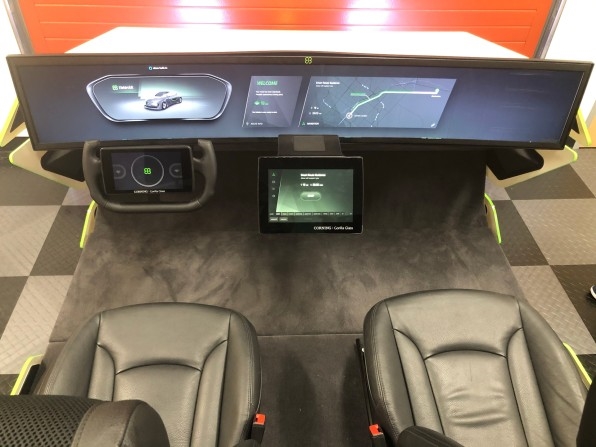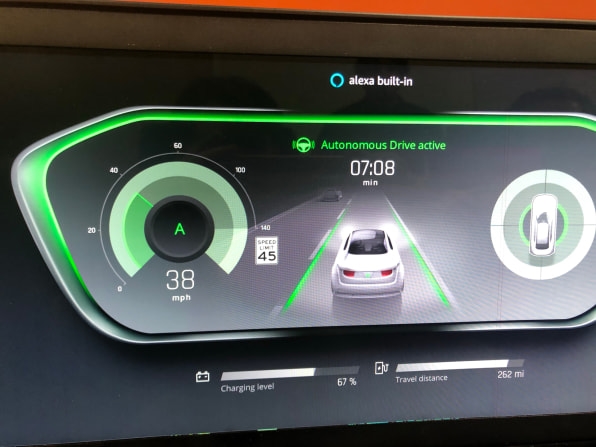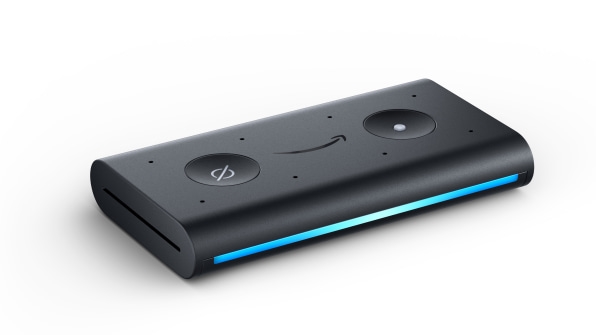“Alexa, roll down the windows!” Inside Amazon’s quest to get in your car
The demo house Amazon built inside one of the towers at its Seattle headquarters to show off its Echo smart speakers has a new room, and an important one: a garage.
Inside the garage is a concept electric car—or, more specifically, the immobile insides of such a vehicle—that Amazon uses to show automakers the full spectrum of things its Alexa Auto software platform can do. That includes in-car versions of typical Alexa tasks such as audio streaming, messaging, voice calls, and reminders. And because it’s a car, Alexa can also do things like roll the windows up and down and control the cabin temperature, all at the verbal request of the driver.
Amazon has been working hard on Alexa Auto for the past two years. Now it hopes to convince automakers to embed the platform into their new cars.
It won’t be easy. Right now, the most common way that people use a virtual assistant in the car is by bringing the one on their smartphone with them—which, for almost everybody, is either Apple’s Siri or Google’s Assistant. Apple and Google already have mature smartphone “mirroring” products–CarPlay and Android Auto, respectively–that put a pared-down set of mobile experiences onto the in-dash display of the car. Automakers, recognizing the importance of such in-car tech to consumers, have embraced these products.
Unlike Apple and Google, Amazon has no mobile operating system to mirror in the car, and only a few phones come with built-in Alexa. But it does dominate the market for smart speakers, which many people like to use to control gadgets and systems around their home. Amazon may eventually convince consumers that there are real advantages to using the same virtual assistant in the car as in the home.
As with most things it tackles, Amazon is willing to invest copious resources now in hopes of a long-term payoff. Here’s the company’s vision for the voice-controlled car it hopes to sell to automakers and consumers.

[Photo: Mark Sullivan]
Alexa in the car of the future
My visit to the Amazon demo garage started in the kitchen. Alexa Auto principal solutions architect Ricardo DeMatos said to an Echo speaker in the kitchen, “Alexa ask my car to get ready.” At that command, Alexa—which already knew from DeMatos’s demo calendar that the morning included an airplane trip—announced the estimated time to drive the airport and the car’s range based on its current charge level. It also sent the airport as a point of interest to the car.

[Photo: Mark Sullivan]
We walked over to the garage where the demo car was. I sat in the driver’s seat. The large dash display in front of me could be divided up into segments for different types of content. I noticed that the graphics most important to driving were situated closest to the driver, while potential distractions such as music info were further away. A smaller touchscreen was mounted to the steering wheel. Yet another, larger, touchscreen hung down below the dash in the middle for serious mapping and routing work.
I could see a detailed map of the route to the airport covering the half of the dash display farthest away from me. The display just above the steering wheel–a familiar-looking dash console design–showed a relatively narrow set of data, including the car’s battery charge level and range, trip time, MPH, and the current speed limit. Whenever Alexa was speaking or listening, a blue band of light showed in a panel just above the driver’s display.
It lit up when DeMatos, my passenger, suddenly said “Alexa I’m hungry.” The assistant promptly replied with a list of five nearby restaurants, and an offer to provide more information about any of them. That same list was displayed in graphic form on a small square panel just to the right of the driver display.
That panel also displayed a number of things during the demo, including vehicle status information (“your vehicle is now ready to start”), a navigation route summary, and, at one point, a warning of an accident ahead in the route, complete with a helpful graphic of two cars crashing into each other. At one point, the panel widened to more than twice its original size to display the view of the car’s rear-facing camera.
DeMatos said “Alexa turn on the thermostat.” I saw the number change on the smart thermostat installed on the wall in the garage. He said “Alexa open the garage door,” and the one in front of us went up. He said “Alexa resume my book on Audible” and the book he’d been reading at home resumed play in the car. He said “Alexa play the Grand Tour on Fire TV” and the video showed up on the half of the display that was mostly in front of the passenger seat. You can also ask Alexa to announce on an Echo speaker at home that you’re 15 minutes away, alerting family to your imminent arrival.

[Photo: Mark Sullivan]
As we went for a simulated drive, Alexa piped up: “Autonomous drive is available. Do you need help on how to enable it?” That meant that the car had reached a stretch of road that was equipped with sensors that help support self-driving cars. In the future we’ll likely find stretches of autonomous-friendly road in places we normally use cruise control now. Alexa advised me that I could activate autonomous driving mode by pressing and holding the buttons on both sides of the steering wheel.
Though Amazon’s concept car feels futuristic, its Alexa integration isn’t fanciful. All the functionality is available to automakers and their integrator partners in the Alexa Auto software development kit (SDK) released during in 2018. The electric car simulator was built by Elektrobit, one of a group of integrators Amazon is working with, and was meant to showcase all the cool voice-enabled services contained in the SDK. Elektrobit put in a bit of its own special sauce, too.
“It’s built using the SDK, but they [Elektrobit] put a messaging layer on top of that so that it goes to various components that the vehicle has,” says DeMatos. “Not all cars have these three screens, but the SDK can support advanced vehicles like this.”
Next week, Amazon is set to announce the second version of the Alexa Auto SDK. This update will allow Alexa to do more things when the car’s internet connection is interrupted, by switching to to a mobile phone (connected to the car via Bluetooth or USB) for the connection needed to call, message, or stream music from services such as Amazon Music and Pandora. The new SDK also enables a couple of new offline car-control features, including the ability to turn on defrost and in-cabin lighting. However, Alexa Auto SDK still does not support the ability to control the ignition, door locks, or headlights using voice commands, whether the car has an internet connection or not. Amazon says those capabilities will be enabled in future versions.
If it sounds like Alexa Auto remains a work in progress . . . well, it is. Amazon, which has integration deals with Audi and BMW, says the Alexa implementations were largely built by the automakers themselves and convey only part of its vision for how its voice assistant can work in the car.
“We let them control building the software themselves . . . and it’s not the kind of full experience that we’re building,” says Alexa Auto VP Ned Curic of the current Alexa integration in Audi and BMW vehicles. Curic is an ex-Toyota exec brought in by Amazon in 2017 to sell the Alexa Auto effort to automakers. He says fuller Alexa integrations will show up in other new cars in 2021 and 2022.
A wary relationship
Getting Alexa into vehicles isn’t just about making the necessary technology available. For years, automakers have been trying to work out the best ways to work with big consumer tech companies like Amazon, Google, and Apple. They know that it’s important to car buyers that new models are compatible with the tech they use outside the car. But at the same time, automakers have used the in-cabin experience as an important way to connect with consumers and differentiate their vehicles from those of rivals. They worry about ceding that experience to some tech company—especially if it’s offering off-the-shelf software that will also show up in competitors’ cars.
Gartner analyst Mike Ramsey believes that Amazon has indeed encountered a hesitance among automakers to give Alexa a high-profile role inside the car. “Car companies are threatened by giving up autonomy . . . and giving Alexa the ability to control the vehicle and its internal controls,” he says.
Ramsey points out that Google encountered the same resistance when it began offering automakers a whole operating system for the car in the form of Android Auto OS. But, he adds, the industry is beginning to warm up to Google’s OS. Why? Apps.
“Car companies realized that they just couldn’t offer the level of capability on their own without the power of scale that Android gives them, and the ability to use all these common applications,” Ramsey says. Furthermore, the industry appears to be moving in the direction of integrating consumer-facing software from tech companies more deeply into its in-car systems, going beyond the simple mirroring offered by Android Auto and CarPlay.
If automakers are becoming more willing to give Big Tech brands a higher profile in their cars, Amazon could benefit from it even more than Google. Amazon’s approach of embedding its voice assistant alongside the automakers’ existing head end system mighty be seen as an attractive middle ground between supporting smartphone mirroring solutions (Android Auto, CarPlay) and ceding the whole operating system to a tech company (Android Auto OS).
Amazon’s strategy is to give automakers the ability to meld rich Alexa functionality with their own unique features. “We think the best Alexa experience in the car is one that feels like an extension of the existing in-cabin experience and complements services built by the automaker and their suppliers,” says Curic. “That’s why we built Alexa Auto as an SDK rather than a full operating system.”
Other ways into the car
In the short term, Amazon has a number of other tactics to put Alexa in cars. The company is using apps to bring Alexa services to certain cars. For instance, the Ford+Alexa app lets users request media, driving directions that display on the head end display, and (if users also have the Alexa app on their phone) control smart devices and routines in the home.
GM, Hyundai, Mercedes-Benz, and others have created connected car skills so that customers can turn on their car with an Alexa command, lock or unlock the doors, or preheat the car on cold mornings. Amazon is also trying to promote the creation of Alexa skills that might be useful to drivers. The company’s Alexa Fund invested in a Chicago-based company called Parkwhiz that helps drivers locate, reserve, and pay for parking spaces. Right now the selection of car-centric skills is limited, but that may change if developers see that lots of consumers are using Alexa in the car.
Amazon’s hardware team has also built an Echo speaker for the car, the Echo Auto. The small candy bar-shaped gizmo, which sits on the dash and uses a smartphone for internet connectivity, has an array of sensitive microphones that can hear users’ voice commands clearly even when the music is playing or the windows are down. The device has gotten mixed reviews so far, but Amazon says it’s working hard to improve it. At present, the device is available on an invite-only basis, selling for half of its eventual $50 retail price.

Along with building its own Alexa-powered aftermarket gadget, Amazon has worked with several accessory makers on devices that can respond to Alexa voice commands. Nextbase makes a couple of Alexa-enabled dash cams. iOttie has a smartphone mount with Alexa baked in. Garmin sells several Alexa-enabled navigation devices.
The big question
Regardless of how Alexa makes it into the car, a nagging question remains: What cool features and experiences can Amazon’s assistant bring to consumers that they can’t already get by just connecting their smartphone to the dash?
The answer isn’t obvious. Both Apple’s CarPlay and Google’s Android Auto offer many of the same in-car information and entertainment services that Alexa Auto proposes. The navigation and location services in the Google and Apple products are comparable or superior. And Android Auto and CarPlay each offer a growing list of features that control home devices connected to their respective smart home platforms.
While Apple and Google are making connections between their car platforms and their home platforms, Amazon still has the edge in the home. It controls between 60% and 70% of the smart speaker market, and integrates with far more third party smart home devices than Google Home or Apple’s HomeKit do. More people control their smart home devices via voice using Alexa than with Siri or Assistant, and many of those Alexa home users also own Android or iOS phones.
Amazon has to nail those services that allow users to feel like the car is just another room in the home with an Alexa device in it. Telling Alexa in the car to do things back home will have to work perfectly. And the company will have to build lots of new experiences that connect the car with the home, while designing those services to be keenly aware of the unique needs of drivers and passengers.
The stakes are high. There are a billion cars on the road today. For the time being, new car sales are trending up—believe it or not. The AAA says Americans spend 50 minutes behind the wheel each day on average.
And as we enter the age of autonomous driving, our vehicles may begin to look more like little living rooms than passenger spaces. We’ll need to watch the road a little less, and may have even more yen for the kinds of entertainment, information, and services that virtual assistants bring.
Amazon has a chance to shape how Big Tech and automakers will work together, and ultimately help define the role of voice in the cars of the future. Even with Amazon-scale ambition and investment, it won’t be a drive in the park. It may come down to how well Alexa enables cool new tech experiences in the car without drowning out the brand of the automaker.
Fast Company , Read Full Story
(61)



